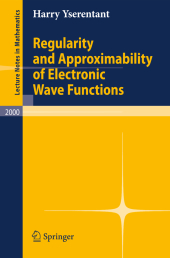 Neuerscheinungen 2010Stand: 2020-01-07 |
Schnellsuche
ISBN/Stichwort/Autor
|
Herderstraße 10
10625 Berlin
Tel.: 030 315 714 16
Fax 030 315 714 14
info@buchspektrum.de |

Harry Yserentant
Regularity and Approximability of Electronic Wave Functions
2010. viii, 188 S. 6 SW-Abb. 238 mm
Verlag/Jahr: SPRINGER, BERLIN 2010
ISBN: 3-642-12247-7 (3642122477)
Neue ISBN: 978-3-642-12247-7 (9783642122477)
Preis und Lieferzeit: Bitte klicken
The electronic Schrodi nger equation describes the motion of N electrons under Coulomb interaction forces in a eld of clamped nuclei. Solutions of this equation depend on 3N variables, three spatial dimensions for each electron. Approxim- ing the solutions is thus inordinately challenging, and it is conventionally believed that a reduction to simpli ed models, such as those of the Hartree-Fock method or density functional theory, is the only tenable approach. This book seeks to c- vince the reader that this conventional wisdom need not be ironclad: the regularity of the solutions, which increases with the number of electrons, the decay behavior of their mixed derivatives, and the antisymmetry enforced by the Pauli principle contribute properties that allow these functions to be approximated with an order of complexity which comes arbitrarily close to that for a system of one or two electrons. The present notes arose from lectures that I gave in Berlin during the academic year 2008/09 to introduce beginning graduate students of mathematics into this subject. They are kept on an intermediate level that should be accessible to an audience of this kind as well as to physicists and theoretical chemists with a c- responding mathematical training.
and Outline.- Fourier Analysis.- The Basics of Quantum Mechanics.- The Electronic Schrödinger Equation.- Spectrum and Exponential Decay.- Existence and Decay of Mixed Derivatives.- Eigenfunction Expansions.- Convergence Rates and Complexity Bounds.- The Radial-Angular Decomposition.
From the reviews:
"This monograph discusses the possible direct approximation of the wavefunction itself, in view of several nice properties of the functions at hand (spatial exponential decay, symmetries, regularity, etc.). ... the book is very pleasant to read, having been written very carefully, and with many proofs provided explicitly. The text should be understandable to any graduate student in (applied) mathematics, as well as students and researchers from chemistry and physics ... ." (Gabriel Stoltz, Mathematical Reviews, Issue 2011 d)


